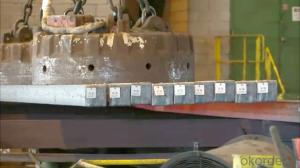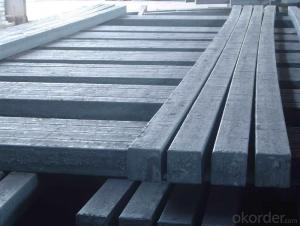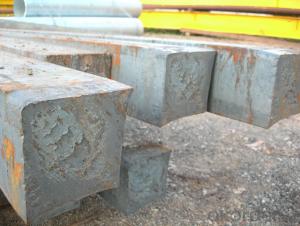Prime square alloy steel billet 145mm Q235
- Loading Port:
- Shanghai
- Payment Terms:
- TT OR LC
- Min Order Qty:
- 100 m.t.
- Supply Capability:
- 10000 m.t./month
OKorder Service Pledge
OKorder Financial Service
You Might Also Like
Structure of Prime square alloy steel billet 145mm Q235

Description of Prime square alloy steel billet 145mm Q235
1) Excellent corrosion resistance: The zinc layer provides a good protection of Pre-painted Galvanizeed Steel Sheet.
2) High heat resistance: The reflective surface of the material aids in efficiently reflecting the sunlight away and in turn reducing the amount of heat transmitted. The thermal reflectivity converts into energy savings.
3) Aesthetics: Pre-Painted Galvanized steel sheet is available in plethora of patterns and multiple sizes as per the requirements that given by our customers.
4) Versatility: can be used in the various areas.

Main Feature of Prime square alloy steel billet 145mm Q235
Manufacture Progress:HRC-CRC-GALVANIZED-COLOR COATED
Application : Construction, electrical, transportation, steel plant, composite board plant, steel tile factory
Payment & Shipping Terms:T/T ,L/C, and FOB CHINA
Minimum Order Quantity: 25Tons
Packge Type: Moisture-proof paper inner,Steel outside,Bundle by steel rope.
Package in Container : Wood as a foot pad, wire rope reinforcement,PPGI steel coil tied together by steel rope.
Applications of Prime square alloy steel billet 145mm Q235
1) Excellent corrosion resistance: The zinc layer provides a good protection of Pre-painted Galvanizeed Steel Sheet.
2) High heat resistance: The reflective surface of the material aids in efficiently reflecting the sunlight away and in turn reducing the amount of heat transmitted. The thermal reflectivity converts into energy savings.
3) Aesthetics: Pre-Painted Galvanized steel sheet is available in plethora of patterns and multiple sizes as per the requirements that given by our customers.
4) Versatility: can be used in the various areas.

Specifications of Prime square alloy steel billet 145mm Q235
Product | Billet |
Material Grade | SGCC / SGCH / DX51D+AZ, etc |
Thickness | 0.6-3.0mm |
Width | 500-1500mm |
Tolerance | Thickness: +/-0.02mm , Width:+/-2mm |
Zinc-coating | Z30-150g/m2 |
Technique | Raw material: Hot rolled steel coil --> Cold rolled_>hot dipped galvalume |
Surface | Dried, Chromated, Unoiled |
Spangle | Regular spangle , small spangle, zero spangle |
ID | 508MM 610MM |
Coil weight | 1-25MT |
Export package | Cardboard inner sleeves, Waterproof paper, galvanized steel covered and steel strip packed |
FAQ of Prime square alloy steel billet 145mm Q235
We have organized several common questions for our clients,may help you sincerely:
1. How Can I Visit There?
Our company is located in Tianjin City, China, near Beijing. You can fly to Tianjin Airport Directly. All our clients, from home or aboard, are warmly welcome to visit us!
2. How Can I Get Some Sample?
We are honored to offer you sample.
3. Why choose CNBM?
we always fix steel produce in container well to make it safe arrive at destination port
we always provide best and professional forward service for our buyer
we always apply 14days free detention for our buyers container in destination
we provide one set After-sales service for our buyer
we provide China inland steel market price report
we help our buyer become number one in local market .
- Q:What are the main factors affecting the machinability of alloy steel billets?
- Several key factors influence the machinability of alloy steel billets. Firstly, the machinability can be affected by the alloy composition of the steel. Different alloying elements, including chromium, nickel, molybdenum, and vanadium, have varying impacts on the machinability. Chromium and molybdenum, which form hard carbides, tend to decrease machinability, while nickel and vanadium, which promote the formation of softer carbides, can enhance machinability. Secondly, the heat treatment of the alloy steel billets significantly impacts machinability. Processes such as annealing, normalizing, or quenching and tempering can alter the microstructure and hardness of the steel. Proper heat treatment can improve machinability by reducing hardness and increasing toughness, while improper heat treatment can result in increased hardness and decreased machinability. Thirdly, the presence of impurities and inclusions in the alloy steel billets can affect machinability. Inclusions, such as sulfides, oxides, and non-metallic particles, can cause tool wear and chip breakability issues during machining. Therefore, the cleanliness and purity of the alloy steel billets are crucial factors in determining machinability. Furthermore, the mechanical properties of the alloy steel, such as hardness, strength, and ductility, can influence machinability. Higher hardness and strength levels can make machining more challenging, while increased ductility and toughness can improve machinability. Lastly, the cutting conditions and machining parameters, including cutting speed, feed rate, depth of cut, and tool material, also impact machinability. Optimal cutting conditions should be selected based on the specific alloy steel composition and desired machinability. Adequate cooling and lubrication during machining are also essential to reduce friction and heat, preventing tool wear and improving machinability. In conclusion, the machinability of alloy steel billets is influenced by factors such as alloy composition, heat treatment, impurities and inclusions, mechanical properties, and cutting conditions. Proper consideration of these factors can help optimize the machinability of alloy steel and ensure efficient and effective machining processes.
- Q:How do steel billets contribute to the overall fire resistance of a structure?
- Steel billets do not directly contribute to the fire resistance of a structure. However, steel is a fire-resistant material and when used in the construction of a building, it can enhance the overall fire resistance by providing structural integrity and stability even at high temperatures.
- Q:What is the role of steel billets in the production of automotive components?
- Steel billets play a crucial role in the production of automotive components. These billets are semi-finished metal products that serve as the raw material for various parts used in the automotive industry. Firstly, steel billets are used to manufacture engine components such as crankshafts, camshafts, and connecting rods. These are vital parts that contribute to the smooth functioning of the engine. The strong and durable properties of steel make it an ideal material for these components, ensuring they can withstand the high temperatures and pressures within the engine. Secondly, steel billets are used to produce chassis and suspension components. These include parts like control arms, steering knuckles, and axle shafts, which are responsible for the vehicle's stability, maneuverability, and overall performance. Steel's high strength-to-weight ratio and excellent fatigue resistance make it suitable for these safety-critical components. Furthermore, steel billets are utilized in the production of transmission and drivetrain components. These include gears, shafts, and clutch plates, which are essential for transmitting power from the engine to the wheels. Steel's toughness, wear resistance, and ability to handle high torque loads make it an ideal material for these parts, ensuring their durability and reliability. Additionally, steel billets are used in the manufacture of body and interior components. These can include door hinges, brackets, seat frames, and various structural parts. Steel's versatility, formability, and corrosion resistance make it an excellent choice for these components, providing strength and protection to the vehicle's occupants. Overall, steel billets form the foundation for the production of a wide range of automotive components. They provide the necessary strength, durability, and reliability required for critical parts in engines, chassis, transmission systems, and body structures. Without steel billets, the automotive industry would struggle to produce high-quality and safe vehicles.
- Q:Use medium frequency furnace (1 million 500 thousand volt ampere) to produce 1 ton cast steel blank, how much kilowatt hour is consumed?
- Look at the quality of scrap and the operation of workers, power consumption is generally between 550~650.
- Q:Billet prices skyrocketing weekend, Southern China steel prices rose?
- In December 5th, the billet price in Hebei was 2780 yuan per ton, a new high since two years and three months, a rise of more than 85% over the same period of last year.
- Q:How are steel billets stored and transported?
- Steel billets are typically stored outdoors in large yards or warehouses, where they are organized in stacks or rows. To protect them from corrosion, billets are often covered with tarpaulins or anti-rust coatings. When it comes to transportation, steel billets are usually moved using heavy machinery like cranes or forklifts. They are loaded onto trucks, railcars, or ships, depending on the distance to be traveled. To ensure safety during transport, billets are secured with chains, straps, or other fastening methods to prevent shifting or falling.
- Q:What are the different types of cutting techniques used for steel billets?
- Different cutting techniques are employed for steel billets, depending on the specific requirements of the project. Several commonly used techniques include: 1. Sawing: This traditional and widely utilized method involves cutting through the steel billet using a saw blade. It can be done manually or with automated sawing machines, making it suitable for both small and large billets. 2. Flame Cutting: Also known as oxy-fuel cutting, this technique employs a flame torch to heat the steel to its kindling temperature. Then, a jet of oxygen is introduced to burn through the metal. It is frequently used for cutting thicker billets and can be performed manually or with CNC-controlled equipment. 3. Plasma Cutting: By utilizing a high-velocity jet of ionized gas, plasma cutting melts and blows away the steel. This technique is particularly effective for cutting billets with complex shapes or contours. It is often automated and produces clean and precise cuts. 4. Waterjet Cutting: This technique involves the use of a high-pressure jet of water combined with abrasive particles to cut through the steel billet. It is ideal for materials sensitive to heat, as it minimizes heat-affected zones. Waterjet cutting is capable of handling various thicknesses and shapes of billets. 5. Laser Cutting: Laser cutting employs a high-powered laser beam to melt and vaporize the steel, resulting in a clean and precise cut. It is highly accurate and suitable for cutting intricate shapes and designs. Laser cutting is commonly automated and widely used in industrial settings. Factors such as desired precision, speed, material thickness, and budget must be considered when selecting the most appropriate cutting technique for steel billets. Each technique has its own advantages and limitations, and choosing the right one can significantly impact the quality and efficiency of the cutting process.
- Q:How are steel billets recycled or reused?
- Steel billets, which are semi-finished metal products, are commonly recycled or reused in various ways. One common method of recycling steel billets is through the process of electric arc furnace (EAF) steelmaking. In this method, the billets are melted down in an electric arc furnace and then used to produce new steel products. This process not only allows for the efficient use of resources but also helps in reducing greenhouse gas emissions and energy consumption compared to primary steel production. Steel billets can also be reused in various industries such as construction, automotive, and manufacturing. They can be reshaped and reformed to create new steel products or used as raw material for forging, rolling, or extrusion processes. By reusing steel billets, the industry can reduce the demand for newly manufactured steel and conserve natural resources. Additionally, steel billets can be recycled through a process called continuous casting. In this process, the molten steel is poured into a continuous casting machine, which produces a solid billet. These billets can be further processed into various steel products such as bars, rods, or wire through hot rolling or cold rolling processes. Furthermore, steel billets can be melted and recast into other forms through the process of remelting. This can be done using technologies like induction melting or vacuum arc remelting, which help in purifying the steel and obtaining desired chemical and mechanical properties. Remelting allows for the production of high-quality steel billets that can be used in specialized applications such as aerospace, defense, or medical industries. In conclusion, steel billets are recycled or reused through various processes such as electric arc furnace steelmaking, continuous casting, remelting, and reshaping. These methods not only contribute to the sustainability of the steel industry but also help in conserving resources, reducing emissions, and meeting the growing demand for steel products.
- Q:What are the common testing methods used for quality control of steel billets?
- There are several common testing methods used for quality control of steel billets. These methods ensure that the billets meet the required specifications and are suitable for further processing. 1. Visual Inspection: This is the initial step in quality control, where the billets are visually inspected for any surface defects such as cracks, seams, or discontinuities. 2. Dimensional Inspection: Billets are measured using various instruments to ensure they meet the specified length, width, and thickness requirements. 3. Ultrasonic Testing (UT): This non-destructive testing method uses high-frequency sound waves to detect internal defects in the billets. UT can identify defects such as inclusions, voids, or cracks that are not visible to the naked eye. 4. Magnetic Particle Inspection (MPI): This method involves magnetizing the billets and applying iron particles to detect surface and near-surface defects. Any defects will cause the particles to gather, indicating the presence of a defect. 5. Dye Penetrant Inspection (DPI): It involves applying a liquid dye to the surface of the billets, which seeps into any surface cracks or defects. After a certain time, excess dye is removed, and a developer is applied to make the defects visible. 6. Hardness Testing: This method measures the hardness of the billets using various techniques like Rockwell, Brinell, or Vickers hardness testing. It helps determine the billet's strength and resistance to deformation. 7. Chemical Analysis: Chemical composition analysis is conducted to ensure that the steel billets meet the required chemical specifications. This is done using spectroscopic techniques like Optical Emission Spectroscopy or X-Ray Fluorescence. 8. Microstructure Examination: A microscopic examination is performed to study the microstructure of the steel billets. It helps determine the grain size, presence of inclusions, and overall quality of the steel. By employing these testing methods, manufacturers can ensure the quality and reliability of steel billets, which in turn guarantees the safety and performance of the final steel products.
- Q:How are steel billets used in the production of oil and gas pipelines?
- Steel billets are essential in the production of oil and gas pipelines as they serve as the initial material for manufacturing these pipelines. Essentially, steel billets are semi-finished steel products that typically have a rectangular or square shape. To manufacture oil and gas pipelines, a series of manufacturing processes are performed on the steel billets. Initially, the billets are heated to high temperatures in a furnace in a process known as billet heating. This heating process increases the malleability of the steel, making it easier to shape. Once the desired temperature is reached, the billets are then passed through a series of rollers to transform their shape into a cylindrical form. This process, called hot rolling, further enhances the mechanical properties of the steel, making it stronger and more durable. Following hot rolling, the steel goes through a process known as quenching and tempering. Quenching involves rapidly cooling the steel to increase its hardness, while tempering is a heat treatment process that reduces the brittleness of the steel, making it less prone to cracking. After these processes, the steel billets are welded together to form the final pipeline. This welding process ensures the integrity and strength of the pipeline, enabling it to withstand the high pressures and harsh environments associated with oil and gas transportation. In conclusion, steel billets play a crucial role in the production of oil and gas pipelines. They serve as the foundational material and undergo various manufacturing processes to transform into durable and high-strength pipes that efficiently transport oil and gas over long distances.
1. Manufacturer Overview |
|
|---|---|
| Location | |
| Year Established | |
| Annual Output Value | |
| Main Markets | |
| Company Certifications | |
2. Manufacturer Certificates |
|
|---|---|
| a) Certification Name | |
| Range | |
| Reference | |
| Validity Period | |
3. Manufacturer Capability |
|
|---|---|
| a)Trade Capacity | |
| Nearest Port | |
| Export Percentage | |
| No.of Employees in Trade Department | |
| Language Spoken: | |
| b)Factory Information | |
| Factory Size: | |
| No. of Production Lines | |
| Contract Manufacturing | |
| Product Price Range | |
Send your message to us
Prime square alloy steel billet 145mm Q235
- Loading Port:
- Shanghai
- Payment Terms:
- TT OR LC
- Min Order Qty:
- 100 m.t.
- Supply Capability:
- 10000 m.t./month
OKorder Service Pledge
OKorder Financial Service
Similar products
New products
Hot products
Related keywords
































